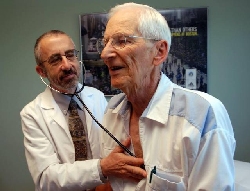- Getting to the root of an I.T. problem.
Click for AUDIO VERSION.
To use this segment in a Radio broadcast or Podcast, send TIM a request.
 When a person visits a doctor to complain about an ailment, it is not uncommon for the patient to try and diagnose the problem himself and prescribe a cure. The doctor listens politely but then asks a series of questions aimed at analyzing the patient's symptoms, for example, "When and where did you first notice this?" "How often does this happen?" "What medication are you currently taking?," etc. By analyzing the symptoms, the physician is trying to diagnose the problem. If he cannot ascertain the problem through questioning or a basic examination, he may order additional tests, such as an MRI, X-rays, a CAT scan, blood tests, urine samples, etc. The point is, the doctor is more interested in attacking the root cause, not just the symptoms.
When a person visits a doctor to complain about an ailment, it is not uncommon for the patient to try and diagnose the problem himself and prescribe a cure. The doctor listens politely but then asks a series of questions aimed at analyzing the patient's symptoms, for example, "When and where did you first notice this?" "How often does this happen?" "What medication are you currently taking?," etc. By analyzing the symptoms, the physician is trying to diagnose the problem. If he cannot ascertain the problem through questioning or a basic examination, he may order additional tests, such as an MRI, X-rays, a CAT scan, blood tests, urine samples, etc. The point is, the doctor is more interested in attacking the root cause, not just the symptoms.
We see this same type of phenomenon in Information Technology (I.T.) related projects where the end-user approaches the I.T. manager with a request for service whereby he sincerely believes he knows the right technical solution to solve his business problems. Two things may result from this request: either the I.T. department will treat the users symptoms, and give him what he wants, thereby not really solving his business problem correctly, or; the I.T. department will study the user's problem more closely, possibly order some tests, and prescribe a solution that properly addresses his problems. Regrettably, this latter approach is rarely performed in companies anymore.
There is still a huge frustration factor between users and I.T. developers. On the one hand, users claim, "They (the I.T. people) don't understand me," and on the other hand, the I.T. people contend the users "don't know what they want." This void between the two groups is unhealthy and not conducive for solving the company's problems. Frustrated, I.T. management tells developers not to ask questions, "Just give them what they want." This scenario is obviously counterproductive, yet commonplace in the corporate world today.
When I am asked how to deal with this situation, I emphasize the doctor-patient analogy as mentioned above. First, the I.T. people have to learn to ask more questions and differentiate symptoms from problems. In other words, let's not be in such a hurry to program a solution before we truly understand the problem. I.T. has a horrible track record in this regard. The idea of specifying user information requirements is the Achilles' Heel of every development project. If it is performed superficially, the wrong solution will inevitably be delivered. Second, the user should play the role of a patient, meaning don't try to prescribe a solution but concentrate on what you truly need and let the doctor (the I.T. department) prescribe a suitable solution. After all, who has more training in this regard, the doctor or the patient? Let the I.T. people do what they're trained to do (and are paid for).
As long as we know our roles and do not try to do the other person's job, we'll get along just fine.
Now turn your head and cough.
Keep the Faith!
P.S. - Also, I have a NEW book, "Before You Vote: Know How Your Government Works", What American youth should know about government, available in Printed, PDF and eBook form. DON'T FORGET GRADUATION DAY. This is the perfect gift!
Note: All trademarks both marked and unmarked belong to their respective companies.
 Tim Bryce is an author, freelance writer and the Managing Director of M&JB Investment Company (M&JB) of Palm Harbor, Florida and has over 40 years of experience in the management consulting field. He can be reached at timb1557@gmail.com
Tim Bryce is an author, freelance writer and the Managing Director of M&JB Investment Company (M&JB) of Palm Harbor, Florida and has over 40 years of experience in the management consulting field. He can be reached at timb1557@gmail.com
For Tim's columns, see: timbryce.com
Like the article? TELL A FRIEND.
Copyright © 2020 by Tim Bryce. All rights reserved.
Listen to Tim on WZIG-FM (104.1) in Palm Harbor,FL; Or tune-in to Tim's channel on YouTube. Click for TIM'S LIBRARY OF AUDIO CLIPS.
 By the time the coronavirus (COVID-19) has run its course, what can we expect from the fall-out? Hopefully, we will learn from this episode and make changes to address future epidemics, and believe me, this will not be the end of it as the media has discovered such disasters are bigger business than mere politics. What can we expect though from this episode and what awaits us in the months ahead?
By the time the coronavirus (COVID-19) has run its course, what can we expect from the fall-out? Hopefully, we will learn from this episode and make changes to address future epidemics, and believe me, this will not be the end of it as the media has discovered such disasters are bigger business than mere politics. What can we expect though from this episode and what awaits us in the months ahead? I think it is time I weighed in on the coronavirus panic choking our country. Currently, we are a nation suffocating in a depressing doom and gloom; where the media seems to take delight in telling us how bad things are, all in the name of improved ratings. Frankly, they haven't hit a bonanza like this in a long time, even in spite of their sloppy reporting. This has been exacerbated by lawyers, accountants, politicians, and a greedy media who will not be happy until the country is ground to a halt. Frankly, this is one American who has had enough.
I think it is time I weighed in on the coronavirus panic choking our country. Currently, we are a nation suffocating in a depressing doom and gloom; where the media seems to take delight in telling us how bad things are, all in the name of improved ratings. Frankly, they haven't hit a bonanza like this in a long time, even in spite of their sloppy reporting. This has been exacerbated by lawyers, accountants, politicians, and a greedy media who will not be happy until the country is ground to a halt. Frankly, this is one American who has had enough. PALM HARBOR, FLORIDA (March 20, 2020) - In an effort to educate High School and College aged students about government, author Tim Bryce has introduced a new book titled, "Before You Vote: Know How Your Government Works." A brief, easy-to-read book aimed at combating the naiveté of those who do not understand how and why their government works.
PALM HARBOR, FLORIDA (March 20, 2020) - In an effort to educate High School and College aged students about government, author Tim Bryce has introduced a new book titled, "Before You Vote: Know How Your Government Works." A brief, easy-to-read book aimed at combating the naiveté of those who do not understand how and why their government works. There are several types of professional certification programs in the world today, be it in engineering, construction, auto repair, medicine, etc. Basically, certification is saying the holder is proficient in a specific subject and should be recognized as a legitimate professional. To the holder, certification looks good on a resume and, thereby, is useful for generating more income. To the customer, certification instills confidence that the holder theoretically knows what he or she is doing. Such programs are supposed to define the level of competency needed to perform certain tasks and means the holder is intimate with specific methods, tools and techniques needed to perform the work. It is also not unusual for certifications to be renewed periodically to assure the holder is staying abreast of industrial developments.
There are several types of professional certification programs in the world today, be it in engineering, construction, auto repair, medicine, etc. Basically, certification is saying the holder is proficient in a specific subject and should be recognized as a legitimate professional. To the holder, certification looks good on a resume and, thereby, is useful for generating more income. To the customer, certification instills confidence that the holder theoretically knows what he or she is doing. Such programs are supposed to define the level of competency needed to perform certain tasks and means the holder is intimate with specific methods, tools and techniques needed to perform the work. It is also not unusual for certifications to be renewed periodically to assure the holder is staying abreast of industrial developments.  Cincinnati's Riverfront Stadium was opened in 1970. At the time, it was considered "state-of-the-art" and easily accommodated two professional teams as their home, the Cincinnati Reds (MLB) and Bengals (NFL). I lived in Cincinnati at the time and vividly recall the sales pitch presented the public. Not only would the stadium be large and spacious with ample parking, the structure would also be easy to maintain and modify to accommodate future considerations. For example, it was claimed the roof could be enclosed, thereby offering an indoor stadium safe from inclement weather. Guess what? The roof was never added, nor much of anything else. Although the stadium was structurally fine and in good shape, it was closed in 2002 and replaced by two separate stadiums, one for baseball and another for football, both at considerable expense to the taxpayer. Whereas Riverfront lasted just 32 years, its predecessor, Crosley Field, a stadium which was certainly no engineering marvel, lasted 58 years. The point is, Riverfront was an excellent example of planned obsolescence. Architects knew the stadium would be demolished and replaced before a nickel would ever be spent on its modification.
Cincinnati's Riverfront Stadium was opened in 1970. At the time, it was considered "state-of-the-art" and easily accommodated two professional teams as their home, the Cincinnati Reds (MLB) and Bengals (NFL). I lived in Cincinnati at the time and vividly recall the sales pitch presented the public. Not only would the stadium be large and spacious with ample parking, the structure would also be easy to maintain and modify to accommodate future considerations. For example, it was claimed the roof could be enclosed, thereby offering an indoor stadium safe from inclement weather. Guess what? The roof was never added, nor much of anything else. Although the stadium was structurally fine and in good shape, it was closed in 2002 and replaced by two separate stadiums, one for baseball and another for football, both at considerable expense to the taxpayer. Whereas Riverfront lasted just 32 years, its predecessor, Crosley Field, a stadium which was certainly no engineering marvel, lasted 58 years. The point is, Riverfront was an excellent example of planned obsolescence. Architects knew the stadium would be demolished and replaced before a nickel would ever be spent on its modification. I've been to Japan several times over the years on business and have had the privilege of seeing Japanese work habits first hand, which are noticeably different than in the United States. As a small example, the first time I visited, I noticed in addition to having Coke and Pepsi machines on a street corner, there were also beer and whiskey machines. I discovered the Japanese were not worried about the youth getting alcohol from the machines as it would cause their families to "lose face" through embarrassment. If we had such machines in this country, they would probably be emptied by our youth faster than the vendors could stock them.
I've been to Japan several times over the years on business and have had the privilege of seeing Japanese work habits first hand, which are noticeably different than in the United States. As a small example, the first time I visited, I noticed in addition to having Coke and Pepsi machines on a street corner, there were also beer and whiskey machines. I discovered the Japanese were not worried about the youth getting alcohol from the machines as it would cause their families to "lose face" through embarrassment. If we had such machines in this country, they would probably be emptied by our youth faster than the vendors could stock them.
 I have discovered a new
I have discovered a new  Is bigger really better? Let me give you a scenario: a small church is started whereby the congregation and clergy tend to their faith and enjoy spiritual harmony. Inevitably, someone suggests constructing a bigger building to encourage membership. A mortgage is secured from a bank, construction begins, and indeed membership starts to grow. So much so, new facilities are added and modifications are made to the building until it becomes a landmark of the community. This, of course, forces the church to become more financially motivated to sustain their operations and recruiting campaigns are initiated to bring in more members. Suddenly, members begin to realize they are more consumed with the business of the church as opposed to practicing their faith, and membership begins to decline.
Is bigger really better? Let me give you a scenario: a small church is started whereby the congregation and clergy tend to their faith and enjoy spiritual harmony. Inevitably, someone suggests constructing a bigger building to encourage membership. A mortgage is secured from a bank, construction begins, and indeed membership starts to grow. So much so, new facilities are added and modifications are made to the building until it becomes a landmark of the community. This, of course, forces the church to become more financially motivated to sustain their operations and recruiting campaigns are initiated to bring in more members. Suddenly, members begin to realize they are more consumed with the business of the church as opposed to practicing their faith, and membership begins to decline.